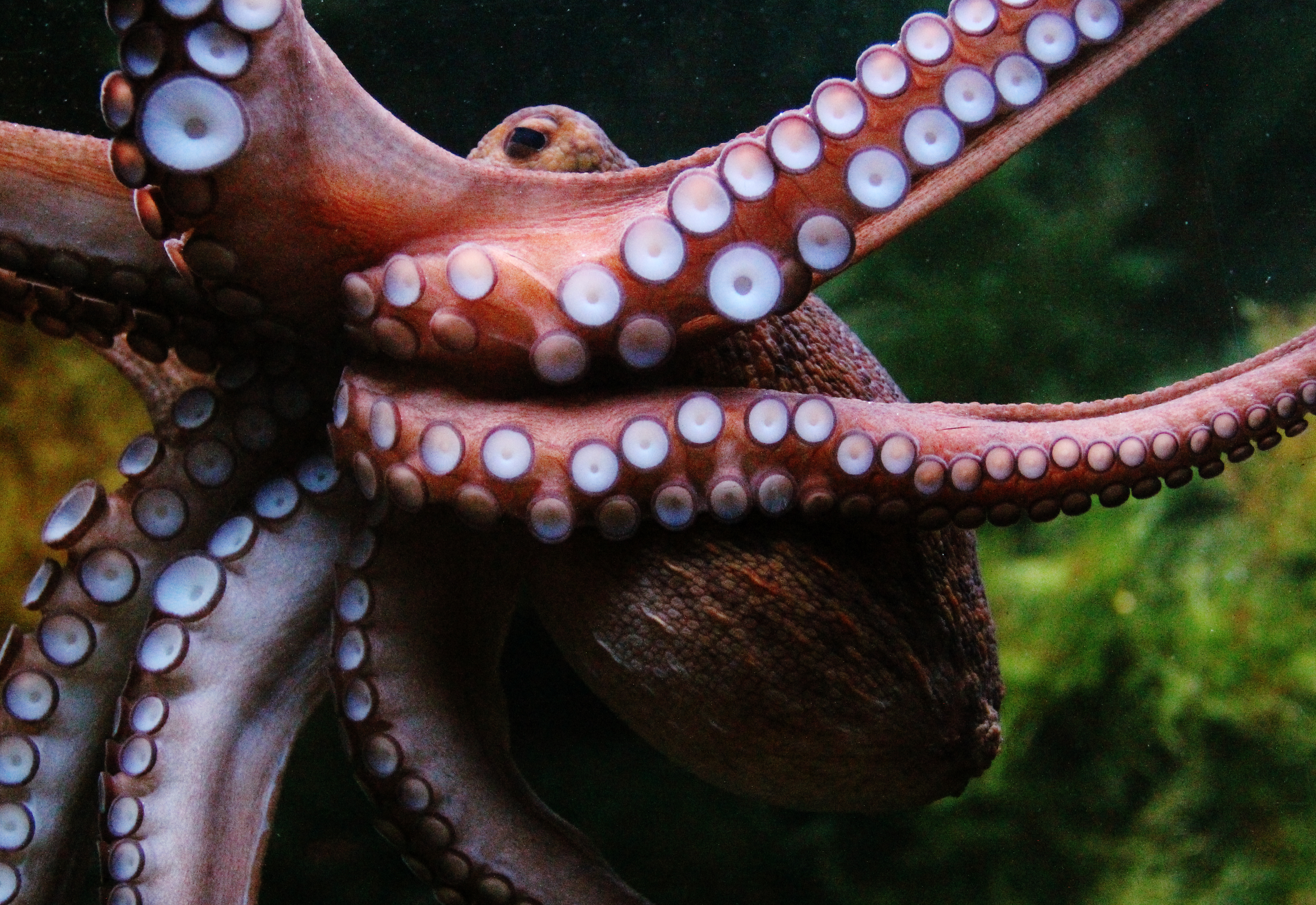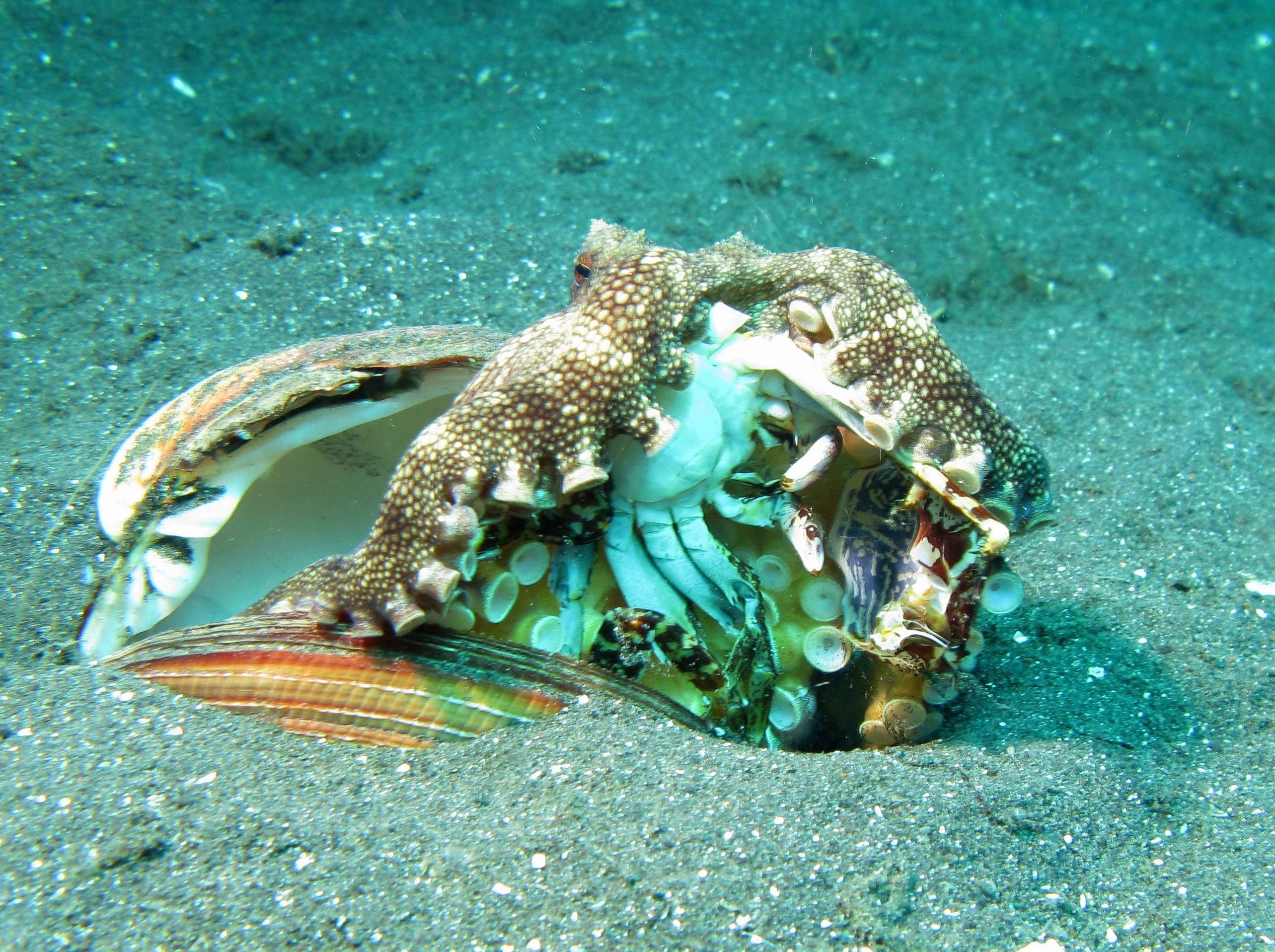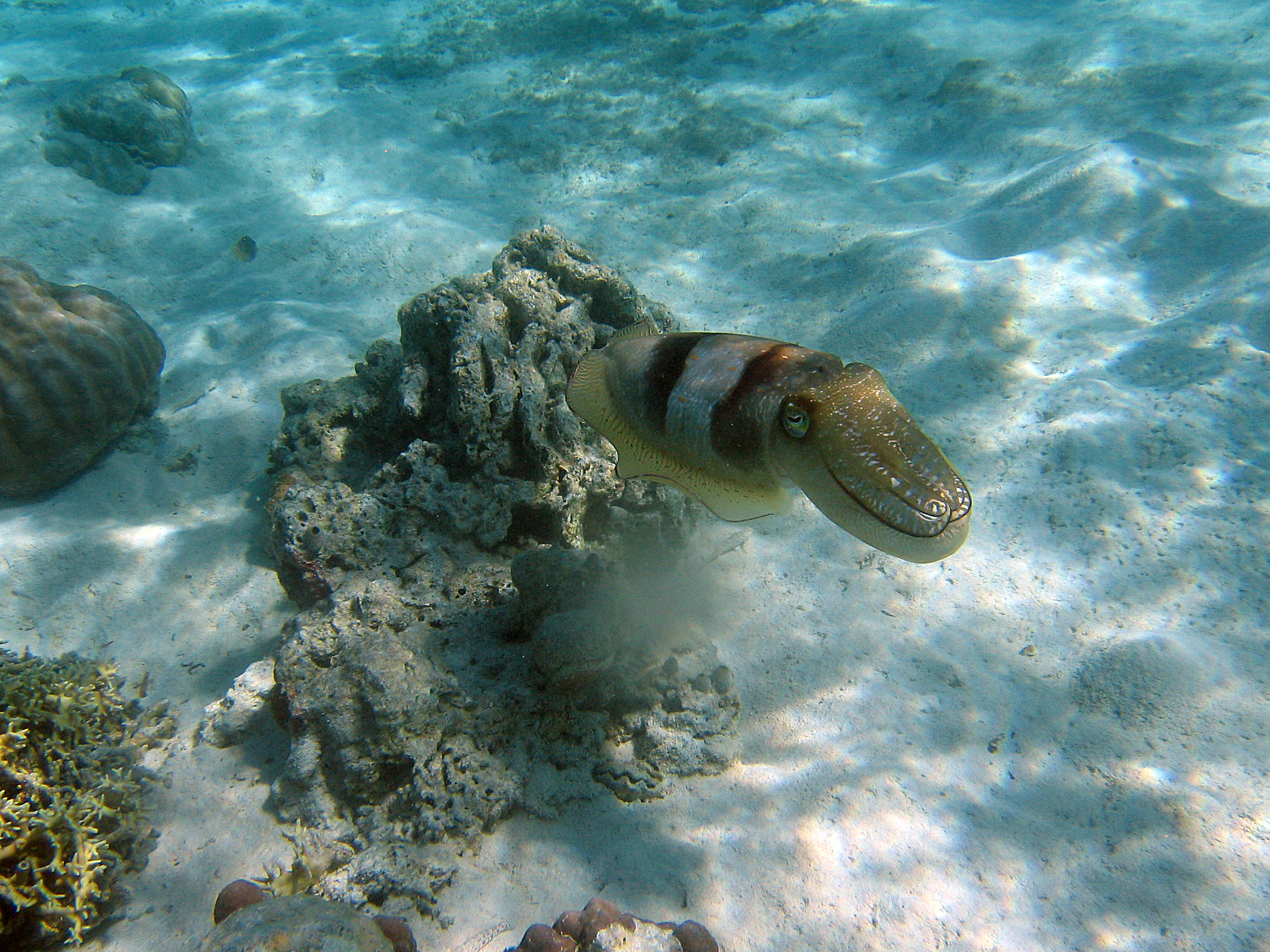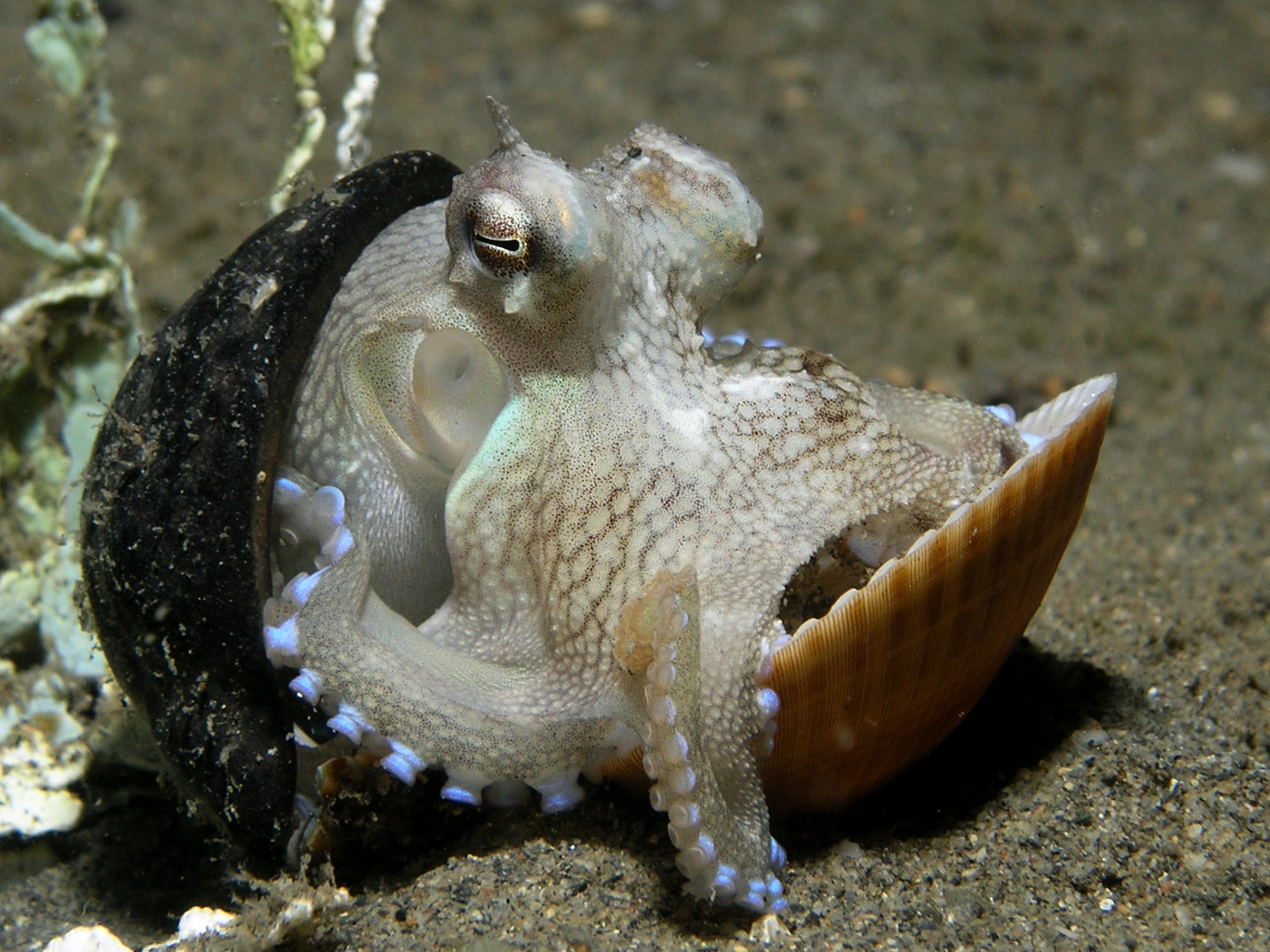Cephalopod intelligence on:
[Wikipedia]
[Google]
[Amazon]
 Cephalopod intelligence is a measure of the cognitive ability of the
Cephalopod intelligence is a measure of the cognitive ability of the
 Unlike most other molluscs, all cephalopods are active predators (with the possible exceptions of the Bigfin squid and vampire squid). Their need to locate and capture their prey has likely been the driving force behind the development of their intelligence.
Crabs, the favorite food source of most octopus species, present significant challenges with their powerful pincers and their potential to exhaust the cephalopod's respiration system from a prolonged pursuit. Because of these challenges, octopuses will sometimes seek out lobster traps and steal the bait inside. They are also known to climb aboard fishing boats and hide in the containers that hold dead or dying crabs.
Captive octopuses have also been known to climb out of their tanks, travel some distance, enter another aquarium to feed, and return to their own aquariums.
Unlike most other molluscs, all cephalopods are active predators (with the possible exceptions of the Bigfin squid and vampire squid). Their need to locate and capture their prey has likely been the driving force behind the development of their intelligence.
Crabs, the favorite food source of most octopus species, present significant challenges with their powerful pincers and their potential to exhaust the cephalopod's respiration system from a prolonged pursuit. Because of these challenges, octopuses will sometimes seek out lobster traps and steal the bait inside. They are also known to climb aboard fishing boats and hide in the containers that hold dead or dying crabs.
Captive octopuses have also been known to climb out of their tanks, travel some distance, enter another aquarium to feed, and return to their own aquariums.
 Although believed to not be the most social of animals, some cephalopods are highly social creatures. When isolated from their own kind, some species have been observed
Although believed to not be the most social of animals, some cephalopods are highly social creatures. When isolated from their own kind, some species have been observed
 The
The
/ref>
File:Oktopus opening a container with screw cap 01.jpg
File:Oktopus opening a container with screw cap 02.jpg
File:Oktopus opening a container with screw cap 03.jpg
File:Oktopus opening a container with screw cap 04.jpg
The highly sensitive suction cups and prehensile arms of octopuses, squid, and cuttlefish allow them to hold and manipulate objects. However, unlike vertebrates, octopus arms have their own neurons, so they do not require input from their central brain to function.
Octopuses can solve complex puzzles requiring pushing or pulling actions, and can also unscrew the lids of containers and open the latches on acrylic boxes in order to obtain the food inside. They can also remember solutions to puzzles and learn to solve the same puzzle presented in different configurations.
Cephalopods benefit from Behavioral enrichment, environmental enrichment, which indicates behavioral and neuronal flexibility not exhibited by most other invertebrates. For example, captive octopuses require stimulation or they will become lethargic.
At the Sea Star Aquarium in
 Due to their intelligence, cephalopods are commonly protected by animal testing regulations that do not usually apply to invertebrates.
In the UK from 1993 to 2012, the common octopus (''
Due to their intelligence, cephalopods are commonly protected by animal testing regulations that do not usually apply to invertebrates.
In the UK from 1993 to 2012, the common octopus (''
''So you think you're smarter than a cephalopod?''
by Wendy Williams, At the Smithsonian's Ocean Portal.
''What behavior can we expect of octopuses?''
by Dr. Jennifer Mather, Department of Psychology and Neuroscience, University of Lethbridge and Roland C. Anderson, The Seattle Aquarium.
''Is the octopus really the invertebrate intellect of the sea?''
by Doug Stewart. In: National Wildlife. Feb/Mar 1997, vol.35 no.2.
''Giant Octopus – Mighty but Secretive Denizen of the Deep''
from the National Zoo in Washington D.C.
''Living Fossils Have Long- And Short-term Memory Despite Lacking Brain Structures Of Modern Cephalopods''
*
Octopuses are Smart Suckers!?
By Dr. Jennifer Mather, Department of Psychology and Neuroscience, University of Lethbridge and Roland C. Anderson, The Seattle Aquarium *
The Diversity and Evolution of Invertebrate Nervous Systems
''Set Institute''. Retrieved 12 December 2014. * * * * * {{animal cognition Animal intelligence
 Cephalopod intelligence is a measure of the cognitive ability of the
Cephalopod intelligence is a measure of the cognitive ability of the cephalopod
A cephalopod is any member of the molluscan Taxonomic rank, class Cephalopoda (Greek language, Greek plural , ; "head-feet") such as a squid, octopus, cuttlefish, or nautilus. These exclusively marine animals are characterized by bilateral symm ...
class of molluscs
Mollusca is a phylum of protostome, protostomic invertebrate animals, whose members are known as molluscs or mollusks (). Around 76,000 extant taxon, extant species of molluscs are recognized, making it the second-largest animal phylum ...
.
Intelligence is generally defined as the process of acquiring, storing, retrieving, combining, and comparing information and skills. Though these criteria are difficult to measure in nonhuman animals, cephalopods are the most intelligent invertebrates
Invertebrates are animals that neither develop nor retain a vertebral column (commonly known as a ''spine'' or ''backbone''), which evolved from the notochord. It is a paraphyletic grouping including all animals excluding the chordate subphylum ...
. The study of cephalopod intelligence also has an important comparative aspect in the broader understanding of animal cognition
Animal cognition encompasses the mental capacities of non-human animals, including insect cognition. The study of animal conditioning and learning used in this field was developed from comparative psychology. It has also been strongly influ ...
because it relies on a nervous system that is fundamentally different from that of vertebrates
Vertebrates () are animals with a vertebral column (backbone or spine), and a cranium, or skull. The vertebral column surrounds and protects the spinal cord, while the cranium protects the brain.
The vertebrates make up the subphylum Vertebra ...
. In particular, the Coleoidea
Coleoidea
or Dibranchiata is one of the two subclasses of cephalopod molluscs containing all the various taxa popularly thought of as "soft-bodied" or "shell-less" (i.e. octopus, squid and cuttlefish). Unlike its extant sister group Nauti ...
subclass (cuttlefish
Cuttlefish, or cuttles, are Marine (ocean), marine Mollusca, molluscs of the order (biology), suborder Sepiina. They belong to the class (biology), class Cephalopoda which also includes squid, octopuses, and nautiluses. Cuttlefish have a unique ...
, squid
A squid (: squid) is a mollusc with an elongated soft body, large eyes, eight cephalopod limb, arms, and two tentacles in the orders Myopsida, Oegopsida, and Bathyteuthida (though many other molluscs within the broader Neocoleoidea are also ...
, and octopuses
An octopus (: octopuses or octopodes) is a soft-bodied, eight-limbed Mollusca, mollusc of the order (biology), order Octopoda (, ). The order consists of some 300 species and is grouped within the class Cephalopoda with squids, cuttlefish, ...
) is thought to contain the most intelligent invertebrates
Invertebrates are animals that neither develop nor retain a vertebral column (commonly known as a ''spine'' or ''backbone''), which evolved from the notochord. It is a paraphyletic grouping including all animals excluding the chordate subphylum ...
. It is also thought to be an important example of advanced cognitive evolution in animals, though nautilus intelligence is also a subject of growing interest among zoologists.
The scope of cephalopod intelligence and learning capability is controversial within the biological community, complicated by the inherent complexity of quantifying non-vertebrate intelligence. In spite of this, the existence of impressive spatial learning
In cognitive psychology and neuroscience, spatial memory is a form of memory responsible for the recording and recovery of information needed to plan a course to a location and to recall the location of an object or the occurrence of an event. Sp ...
capacity, navigational
Navigation is a field of study that focuses on the process of monitoring and controlling the movement of a craft or vehicle from one place to another.Bowditch, 2003:799. The field of navigation includes four general categories: land navigation, ...
abilities, and predatory
Predation is a biological interaction in which one organism, the predator, kills and eats another organism, its prey. It is one of a family of common feeding behaviours that includes parasitism and micropredation (which usually do not kill ...
techniques in cephalopods is widely acknowledged. Cephalopods have been compared to intelligent extraterrestrials, due to their convergently evolved mammal-like intelligence.
Brain size and structure
Cephalopods have large, well-developed brains, and their brain-to-body mass ratio is the largest among the invertebrates, falling between that ofendothermic
An endothermic process is a chemical or physical process that absorbs heat from its surroundings. In terms of thermodynamics, it is a thermodynamic process with an increase in the enthalpy (or internal energy ) of the system.Oxtoby, D. W; Gillis, ...
and ectothermic vertebrates. The large nerve
A nerve is an enclosed, cable-like bundle of nerve fibers (called axons). Nerves have historically been considered the basic units of the peripheral nervous system. A nerve provides a common pathway for the Electrochemistry, electrochemical nerv ...
fibers of the cephalopod mantle have been widely used for many years as experimental material in neurophysiology
Neurophysiology is a branch of physiology and neuroscience concerned with the functions of the nervous system and their mechanisms. The term ''neurophysiology'' originates from the Greek word ''νεῦρον'' ("nerve") and ''physiology'' (whic ...
; their large diameter (due to lack of a myelin
Myelin Sheath ( ) is a lipid-rich material that in most vertebrates surrounds the axons of neurons to insulate them and increase the rate at which electrical impulses (called action potentials) pass along the axon. The myelinated axon can be lik ...
sheath) makes them relatively easy to study compared with other animals. An octopus's nerves are not limited to the brain. In fact, two-thirds of an octopus's neuron
A neuron (American English), neurone (British English), or nerve cell, is an membrane potential#Cell excitability, excitable cell (biology), cell that fires electric signals called action potentials across a neural network (biology), neural net ...
s are in the nerve cords of its arms. These are capable of complex reflex
In biology, a reflex, or reflex action, is an involuntary, unplanned sequence or action and nearly instantaneous response to a stimulus.
Reflexes are found with varying levels of complexity in organisms with a nervous system. A reflex occurs ...
actions without input from the brain.
Behavior
Predation
 Unlike most other molluscs, all cephalopods are active predators (with the possible exceptions of the Bigfin squid and vampire squid). Their need to locate and capture their prey has likely been the driving force behind the development of their intelligence.
Crabs, the favorite food source of most octopus species, present significant challenges with their powerful pincers and their potential to exhaust the cephalopod's respiration system from a prolonged pursuit. Because of these challenges, octopuses will sometimes seek out lobster traps and steal the bait inside. They are also known to climb aboard fishing boats and hide in the containers that hold dead or dying crabs.
Captive octopuses have also been known to climb out of their tanks, travel some distance, enter another aquarium to feed, and return to their own aquariums.
Unlike most other molluscs, all cephalopods are active predators (with the possible exceptions of the Bigfin squid and vampire squid). Their need to locate and capture their prey has likely been the driving force behind the development of their intelligence.
Crabs, the favorite food source of most octopus species, present significant challenges with their powerful pincers and their potential to exhaust the cephalopod's respiration system from a prolonged pursuit. Because of these challenges, octopuses will sometimes seek out lobster traps and steal the bait inside. They are also known to climb aboard fishing boats and hide in the containers that hold dead or dying crabs.
Captive octopuses have also been known to climb out of their tanks, travel some distance, enter another aquarium to feed, and return to their own aquariums.
Communication
 Although believed to not be the most social of animals, some cephalopods are highly social creatures. When isolated from their own kind, some species have been observed
Although believed to not be the most social of animals, some cephalopods are highly social creatures. When isolated from their own kind, some species have been observed shoaling
In biology, any group of fish that stay together for social reasons are shoaling, and if the group is swimming in the same direction in a coordinated manner, they are schooling. In common usage, the terms are sometimes used rather loosely. Ab ...
with fish.
Cephalopods are able to communicate visually using a diverse range of signals. To produce these signals, cephalopods can use four types of communication elements: chromatic (skin coloration), skin texture (e.g. rough or smooth), posture, and locomotion. Some cephalopods are capable of rapid changes in skin colour and pattern using chromatophores
Chromatophores are cells that produce color, of which many types are Biological pigment, pigment-containing cells, or groups of cells, found in a wide range of animals including amphibians, fish, reptiles, crustaceans and cephalopods. Mammals an ...
, iridophores, and leucophores. This ability almost certainly evolved for camouflage
Camouflage is the use of any combination of materials, coloration, or illumination for concealment, either by making animals or objects hard to see, or by disguising them as something else. Examples include the leopard's spotted coat, the b ...
. However, some squid and cuttlefish use flashing colors and patterns to communicate with each other in various courtship rituals. Caribbean reef squid
The Caribbean reef squid (''Sepioteuthis sepioidea''), commonly called the reef squid, is a species of small, torpedo-shaped squid with undulating fins that extend nearly the entire length of the body, approximately 20 cm (8 in) in length. They ...
can even discriminate between recipients, sending one message using color patterns to a squid on their right, while they send another message to a squid on their left. Tests show that octopuses become more sociable when exposed to the psychoactive drug MDMA
3,4-Methylenedioxymethamphetamine (MDMA), commonly known as ecstasy (tablet form), and molly (crystal form), is an empathogen–entactogenic drug with stimulant and minor Psychedelic drug, psychedelic properties. In studies, it has been used ...
.
The Humboldt squid
The Humboldt squid (''Dosidicus gigas''), also known as jumbo squid or jumbo flying squid, is a large, predatory squid living in the eastern Pacific Ocean. It is the Monotypic taxon, only known species of the genus ''Dosidicus'' of the subfamily ...
shows high amounts of cooperation and communication in its hunting techniques. This was one of the first observations of cooperative hunting in invertebrates.
It is believed that squids are slightly less intelligent than octopuses and cuttlefish; however, various species of squid act more social than other octopuses and cuttlefish, leading some researchers to conclude that squids are on par with dogs in terms of intelligence.
Learning
In laboratory experiments, octopuses can be readily trained to distinguish between different shapes and patterns. In one study on observational learning, Common octopuses(observers) were allowed to watch other octopuses(demonstrators) select one of two objects that differed only in color. Subsequently, the observers consistently selected the same object the demonstrators did. This study concluded thatoctopuses
An octopus (: octopuses or octopodes) is a soft-bodied, eight-limbed Mollusca, mollusc of the order (biology), order Octopoda (, ). The order consists of some 300 species and is grouped within the class Cephalopoda with squids, cuttlefish, ...
are capable of using observational learning
Observational learning is learning that occurs through observing the behavior of others. It is a form of Social learning theory, social learning which takes various forms, based on various processes. In humans, this form of learning seems to not n ...
. However, this is disputed by some. Both octopuses and nautiluses are capable of vertebrate-like spatial learning
In cognitive psychology and neuroscience, spatial memory is a form of memory responsible for the recording and recovery of information needed to plan a course to a location and to recall the location of an object or the occurrence of an event. Sp ...
. Additionally, cuttlefish have been shown to have the capacity for future planning and reward processing after being tested with the Stanford marshmallow experiment
The Stanford marshmallow experiment was a study on delayed gratification in 1970 led by psychologist Walter Mischel, a professor at Stanford University. In this study, a child was offered a choice between one small but immediate reward, or two s ...
.
Tool use
 The
The octopus
An octopus (: octopuses or octopodes) is a soft-bodied, eight-limbed mollusc of the order Octopoda (, ). The order consists of some 300 species and is grouped within the class Cephalopoda with squids, cuttlefish, and nautiloids. Like oth ...
shows flexibility in the use of tools.
At least four individuals of the Veined octopus (''Amphioctopus marginatus'') have been observed retrieving discarded coconut
The coconut tree (''Cocos nucifera'') is a member of the palm tree family (biology), family (Arecaceae) and the only living species of the genus ''Cocos''. The term "coconut" (or the archaic "cocoanut") can refer to the whole coconut palm, ...
shells, transporting them some distance, and then reassembling them for use as a shelter. It is theorized that the octopuses used shells for the same purpose before humans made coconut shells widely available on the sea floor. Other sea creatures construct homes in a similar manner; for example, most hermit crabs
Hermit crabs are anomuran Decapoda, decapod crustaceans of the superfamily (taxonomy), superfamily Paguroidea that have adapted to occupy empty scavenged mollusc shells to protect their fragile exoskeletons. There are over 800 species of hermit c ...
use the discarded shells of other species for habitation, and some crabs place sea anemones on their carapaces for protection and camouflage. However, this behavior lacks some of the complexity of the octopus' behavior, which involves picking up and carrying a tool for later use. (This argument remains contested by a number of biologists, who claim that the shells actually provide protection from bottom-dwelling predators during transport.)
Smaller individuals of the Common blanket octopus (''Tremoctopus violaceus'') will hold the tentacles of the Portuguese man o' war
The Portuguese war (''Physalia physalis''), also known as the man-of-war or bluebottle, is a marine hydrozoan found in the Atlantic Ocean and the Indian Ocean. It is the only species in the genus ''Physalia'', which in turn is the only genus in ...
(whose venom they are immune to), both as a means of protection and as a method of capturing prey.
Octopuses have also been known to deliberately place stones, shells, and even bits of broken bottles to form walls that constrict their den openings. In laboratory studies, the Caribbean dwarf octopus(''Octopus mercatoris)'', a small pygmy species of octopus, has been observed to block its lair using plastic Lego
Lego (, ; ; stylised as LEGO) is a line of plastic construction toys manufactured by the Lego Group, a privately held company based in Billund, Denmark. Lego consists of variously coloured interlocking plastic bricks made of acrylonitri ...
bricks.Oinuma, Colleen, (14 April 2008). "''Octopus mercatoris'' response behavior to novel objects in a laboratory setting: Evidence of play and tool use behavior?" In ''Octopus Tool Use and Play Behavior/ref>
Problem-solving ability
Coburg
Coburg ( , ) is a Town#Germany, town located on the Itz (river), Itz river in the Upper Franconia region of Bavaria, Germany. Long part of one of the Thuringian states of the Ernestine duchies, Wettin line, it joined Bavaria by popular vote only ...
, Germany, an octopus named Otto was known to juggle hermit crabs around, as well as strike the aquarium glass with a rock. On more than one occasion, Otto even caused a short circuit
A short circuit (sometimes abbreviated to short or s/c) is an electrical circuit that allows a current to travel along an unintended path with no or very low electrical impedance. This results in an excessive current flowing through the circuit ...
by shooting a jet of water at the overhead lamp.
Protective legislation
 Due to their intelligence, cephalopods are commonly protected by animal testing regulations that do not usually apply to invertebrates.
In the UK from 1993 to 2012, the common octopus (''
Due to their intelligence, cephalopods are commonly protected by animal testing regulations that do not usually apply to invertebrates.
In the UK from 1993 to 2012, the common octopus (''Octopus vulgaris
The common octopus (''Octopus vulgaris'') is a Mollusca, mollusk belonging to the class Cephalopoda. ''Octopus vulgaris'' is one of the most studied of all octopus species, and also one of the most intelligent. It ranges from the eastern Atlanti ...
'') was the only invertebrate protected under the Animals (Scientific Procedures) Act 1986. Since 2022, all vertebrates, cephalopods, and decapods
The Decapoda or decapods, from Ancient Greek δεκάς (''dekás''), meaning "ten", and πούς (''poús''), meaning "foot", is a large order (biology), order of crustaceans within the class Malacostraca, and includes crabs, lobsters, crayfis ...
have been recognised as sentient by the Animal Welfare (Sentience) Act 2022
The Animal Welfare (Sentience) Act 2022 (c. 22) is an act of the Parliament of the United Kingdom. It was introduced to Parliament by the Government of the United Kingdom at the 2021 State Opening of Parliament. The act recognises animal senti ...
. Cephalopods are the only invertebrates protected under the 2010 European Union
The European Union (EU) is a supranational union, supranational political union, political and economic union of Member state of the European Union, member states that are Geography of the European Union, located primarily in Europe. The u ...
directive " on the protection of animals used for scientific purposes". Some scholars have argued for increased protections for cephalopods in the United States as well.
See also
*Animal cognition
Animal cognition encompasses the mental capacities of non-human animals, including insect cognition. The study of animal conditioning and learning used in this field was developed from comparative psychology. It has also been strongly influ ...
*Animal consciousness
Animal consciousness, or animal awareness, is the Quality (philosophy), quality or state of self-awareness within an animal, or of being aware of an external object or something within itself. In humans, consciousness has been defined as: senti ...
* Octopolis and Octlantis
References
Further reading
''So you think you're smarter than a cephalopod?''
by Wendy Williams, At the Smithsonian's Ocean Portal.
''What behavior can we expect of octopuses?''
by Dr. Jennifer Mather, Department of Psychology and Neuroscience, University of Lethbridge and Roland C. Anderson, The Seattle Aquarium.
''Is the octopus really the invertebrate intellect of the sea?''
by Doug Stewart. In: National Wildlife. Feb/Mar 1997, vol.35 no.2.
''Giant Octopus – Mighty but Secretive Denizen of the Deep''
from the National Zoo in Washington D.C.
''Living Fossils Have Long- And Short-term Memory Despite Lacking Brain Structures Of Modern Cephalopods''
*
Octopuses are Smart Suckers!?
By Dr. Jennifer Mather, Department of Psychology and Neuroscience, University of Lethbridge and Roland C. Anderson, The Seattle Aquarium *
The Diversity and Evolution of Invertebrate Nervous Systems
''Set Institute''. Retrieved 12 December 2014. * * * * * {{animal cognition Animal intelligence
Intelligence
Intelligence has been defined in many ways: the capacity for abstraction, logic, understanding, self-awareness, learning, emotional knowledge, reasoning, planning, creativity, critical thinking, and problem-solving. It can be described as t ...